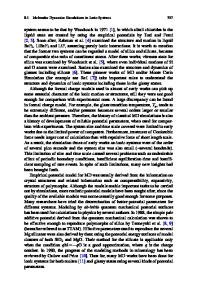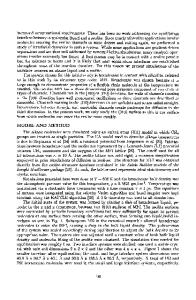Molecular Dynamics Simulations of Ionic Liquids: Influence of Polarization on IL Structure and Ion Transport
- PDF / 508,620 Bytes
- 10 Pages / 612 x 792 pts (letter) Page_size
- 64 Downloads / 338 Views
1082-Q06-04
Molecular Dynamics Simulations of Ionic Liquids: Influence of Polarization on IL Structure and Ion Transport Oleg Borodin Materials Science & Eng, Wasatch Molecular Inc. & University of Utah, MATERIALS SCIENCES & ENGINEERING DEPT., 122 S CENTRAL CAMPUS DR RM 304, SALT LAKE CITY, UT, 84112-0560 ABSTRACT Many-body polarizable force field has been developed and validated for a wide class of ionic liquids. Classical molecular dynamics (MD) simulations have been performed on 29 ionic liquids containing alkyl-imidazolium, alkyl-methyl-pyrrolidinium, butyl-pyridinium, butylmethyl-piperidinium and alkyl-methyl-morpholinium cations and BF4-, PF6- , CF3SO3, CF3BF3, CH3BF3, dicyanamide, bis(trifluoromethane sulfonyl) imide and nitrate cations. MD simulations predicted density, ion self-diffusion coefficient, conductivity and viscosity in good agreement with available experimental data. This presentation will focus on ability of developed force fields to predict condensed phase properties and on understanding the influence of many-body polarizable interactions on the ionic liquid structure and transport. INTRODUCTION Room temperature ionic liquids (IL) have been widely investigated for use in lithium batteries,1-4 biphasic systems for separation and solvents for synthetic and catalytic applications,5 actuators6 and as a reaction media7 because of negligible vapor pressure, excellent thermal and electrochemical stability, good dissolution properties with many organic and inorganic compounds, and low flammability. IL performance can be achieved by tuning the combination of cations and anions to obtain the desired thermodynamic, solvating and transport properties, as well as safety characteristics. For example, higher charge delocalization8, 9 and small ion size10 often reduces viscosity and improves ion transport. The length and nature of substituent groups on IL cations greatly affects the IL melting temperature (Tm), glass transition temperature (Tg), and thermal stability.11 The availability of a large number of cations and anions for ILs presents tremendous opportunities for finding optimal pairs for the design of ILs targeted towards specific applications, but also big challenges. The latter is largely because of an incomplete understanding of the link between structure-property relationships for ILs. In this presentation the relation between ion polarizability and IL structural and transport properties will be discussed. FORCE FIELD DEVELOPMENT Our objective was to develop and validate the force field development methodology that would be applicable to a wide class of ILs. In order to achieve this goal we have selected a set of ILs
for which density, heat of vaporization, ion self-diffusion coefficient, ionic and thermal conductivity, viscosity and crystal structure data are available in the literature. Figure 1 shows the anions and cations of the ILs for which a force field has been developed. One of the reasons for choosing this particular set of cations and anions is that it allows us to thoroughly investi
Data Loading...











